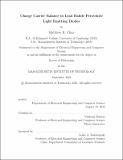Charge Carrier Balance in Lead Halide Perovskite Light Emitting Diodes
Author(s)
Chua, Matthew R.
DownloadThesis PDF (17.50Mb)
Advisor
Bulović, Vladimir
Terms of use
Metadata
Show full item recordAbstract
Charge balance in light emitting diodes (LEDs) is a critical determinant of their performance. Charge balance is directly related to the External Quantum Efficiency (EQE), and is thought to have additional effects on device endurance and stability.
In this thesis I present a series of experiments and simulations to study the charge balance in Lead Halide Perovskite (LHP) emitter LEDs. These LHP LEDs, particularly Near-Infrared Emitters have demonstrated high EQE, and promising lifetime.However for many other emission wavelengths their performance and endurance is
lacking. I first present a modified simultaneous Photoluminescence-Electroluminesence (PLEL) measurement, along with two methods of calibrating the absolute photon flux absorbed, namely Short-circuit current, and Absorption from reflection. This allows the determination of absolute PL efficiency in the device relative to EL efficiency, to obtain an absolute measure of charge balance. Our measurements suggest that in the prototypical high efficiency NIR ITO/ZnO/LHP/TFB/MoO3/Al planar structure, the charge efficiency or 𝜂𝐶𝐵 is 0.83-0.91 , consistent with the high observed EQE of 16-17%.
Next a different hole transport layer poly-TPD is introduced and the device studied relative to the original TFB case. We find that although poly-TPD devices have charge balance approximately 1.3x worse relative to TFB devices, this is insufficient to account for the 3x difference in device EQE when considering the relative PL quantum yields (PLQY) of the emitter under partially-complete stack measurements. By performing PL quantum yield measurements in-situ on a device under hybrid electrical-optical excitation, it is found that the LHP in-device PLQY is increased significantly and transiently by electrical excitation, which allows us to resolve the contradictory charge balance and EQE results.
These experiments are supported by transfer matrix based optical simulations that allow us to account for the possible optical effects encountered in the different PLQY measurement conditions. Optical simulations are also used to convert the observed external PLQY to Internal Quantum Efficiency, 𝜂𝑄𝑌 , for a standard comparison
across all measurements.
This thesis demonstrates the effectiveness of the quasi-DC PLEL measurement in determining absolute charge balance in a LHP device. This method can be further applied to a broader range of LHP devices to gain greater understanding of the effect charge transport layers and LHP emitters have on each other when used to create electrically pumped light emitting systems.
Date issued
2022-09Department
Massachusetts Institute of Technology. Department of Electrical Engineering and Computer SciencePublisher
Massachusetts Institute of Technology